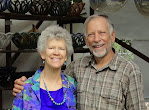We took the overnight express bus from Lima to Arequipa. The Pan-American Highway out of Lima starts as a many-laned freeway and soon becomes a winding two lane road. Avatar was the featured movie of the evening! Later the full moon lit the landscape we could see when we were awake. In one place, sand had blown over a whole lane in the highway. In early morning light one great sand slide glowed mother-of -pearl. The Peruvian coast is desert, punctuated by great oases wherever flow the big rivers out of the Andes. These fertile areas grow great quantities of food: olives, bananas, melons, squash (I´ve seen leaves 12 inches across!), figs (everywhere right now, must be in season, yum), even grains: rice, corn.
Arequipa is a city of nearly a million people, altitude 2,300 meters or 7,800 feet above sea level. It´s hot. Not as hot as Lima, but we´re sweating. Everyone else seems to put on jackets at night as we are finally comfortable. Our goal here was to try to reconnect with some solar cooks we met several years ago, Patricia Gootee and Geovana Rivera, but we had no luck. This city has close to 360 days of sun every year, so is perfect for solar applications. The street near our hotel is full of shops selling solar hot water equipment. A few stores displayed parabolic solar cookers made in Peru. In our wanderings in the city we see many buildings with solar hot water panels and tanks on the rooftops. They have an advantage here where it never freezes--much simpler installation than in cold climates.
We stay at a sweet little hospedaje with an interior garden. Our hostess is 84 year old Blanca. She took us under her wing two years ago and we find ourselves hugging her and her sons who run the place. She has been sick these last three months; we hope she gets better to visit her in two more years.
Just down from our hotel is the Museo del Arte Contemporania, the only contemporary art museum in all of Peru, according to the curator. My favorite is a ceramic piece in the permanent collection: two 24" (60cm) spheres mounted on a glass and iron stand with a mirror below, stoneware with big glassy melted-out drops and writing all around and around. One is in Spanish, "no es lo que haces no es lo que quieres no es lo que esperes no es lo que no haces ..." and the other in English "no more war no more inequity no more disbelief no more pain no more illusions no more words." Picture below:

We meant to go to Puno today, but a strike in Puno against a big dam project, the Inambari Dam, kept us here being tourists an extra day. Tomorrow for sure we will be in Puno with our Taquile family.
Arequipa is a city of nearly a million people, altitude 2,300 meters or 7,800 feet above sea level. It´s hot. Not as hot as Lima, but we´re sweating. Everyone else seems to put on jackets at night as we are finally comfortable. Our goal here was to try to reconnect with some solar cooks we met several years ago, Patricia Gootee and Geovana Rivera, but we had no luck. This city has close to 360 days of sun every year, so is perfect for solar applications. The street near our hotel is full of shops selling solar hot water equipment. A few stores displayed parabolic solar cookers made in Peru. In our wanderings in the city we see many buildings with solar hot water panels and tanks on the rooftops. They have an advantage here where it never freezes--much simpler installation than in cold climates.
We stay at a sweet little hospedaje with an interior garden. Our hostess is 84 year old Blanca. She took us under her wing two years ago and we find ourselves hugging her and her sons who run the place. She has been sick these last three months; we hope she gets better to visit her in two more years.
Just down from our hotel is the Museo del Arte Contemporania, the only contemporary art museum in all of Peru, according to the curator. My favorite is a ceramic piece in the permanent collection: two 24" (60cm) spheres mounted on a glass and iron stand with a mirror below, stoneware with big glassy melted-out drops and writing all around and around. One is in Spanish, "no es lo que haces no es lo que quieres no es lo que esperes no es lo que no haces ..." and the other in English "no more war no more inequity no more disbelief no more pain no more illusions no more words." Picture below:

We meant to go to Puno today, but a strike in Puno against a big dam project, the Inambari Dam, kept us here being tourists an extra day. Tomorrow for sure we will be in Puno with our Taquile family.

Hello down south! Thank you so much for your beautiful descriptions and time spent on your blog! I love the inscription in Spanish/English on the stoneware piece. PEACE!
ReplyDelete